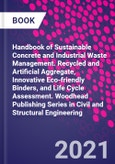The Handbook of Sustainable Concrete and Industrial Waste Management summarizes key research trends in recycling and reusing concrete and industrial waste to reduce their environmental impact. This volume also includes important contributions in collaboration with the CRI-TEST Innovation Lab, Naples - Acerra.
Part one discusses eco-friendly innovative cement and concrete and reviews key substitute materials. Part two analyzes the use of industrial waste as aggregates and the mechanical properties of concrete containing waste materials. Part three discusses differences between innovative binders, focusing on alkali-activated and geopolymer concrete. Part four provides a thorough overview of the life cycle assessment (LCA) of concrete containing industrial wastes and the impacts related to the logistics of wastes, the production of the concrete, and the management of industrial wastes.
By providing research examples, case studies, and practical strategies, this book is a state-of-the-art reference for researchers working in construction materials, civil or structural engineering, and engineers working in the industry.
Please Note: This is an On Demand product, delivery may take up to 11 working days after payment has been received.
Table of Contents
Part 1. Eco-friendly innovative cement and concrete
1. Foamed concrete containing industrial wastes
2. Valorization of industrial by-products and wastes as sustainable construction materials
3. Enunciation of lightweight and self-compacting concretes using non-conventional materials
4. The use of construction and demolition waste as a recycled aggregate in sustainable concrete production: workability, strength, and durability properties
5. Natural fibers
6. Eco-friendly fiber-reinforced concretes
Part 2. Use of industrial waste as aggregates: properties of concrete
7. Energy-saving materials
8. Fresh and mechanical properties of concrete made with recycled plastic aggregates
9. Recycled glass as a concrete component: possibilities and challenges
10. Recycled aggregate concrete: mechanical and durability performance
11. Microstructure and properties of concrete with ceramic wastes
12. Agricultural plastic waste
13. Recycling and applications of steel slag aggregates
14. Quarry waste
15. Implementation of agricultural crop wastes toward green construction materials
16. Balancing sustainability, workability, and hardened behavior in the mix design of self-compacting concrete
17. Design guidelines for structural and non-structural applications
18. Strength and microstructure properties of self-compacting concrete using mineral admixtures. Case study I
19. Durability properties of self-compacting concrete using mineral admixtures. Case study II
Part 3. Innovative binders: alkali-activated and geopolymer concrete
20. Difference between geopolymers and alkali-activated materials
21. Geopolymer binders containing construction and demolition waste
22. On the properties of sustainable concrete containing mineral admixtures
23. Sustainable alkali-activated materials
24. Design guidelines for structural and non-structural applications
25. Future trends: nanomaterials in alkali-activated composites
Part 4. Life cycle assessment (LCA) of concrete
26. Calculation of the environmental impact of the integration of industrial waste in concrete using LCA
27. Role of transport distance on the environmental impact of the construction and demolition waste (CDW) recycling process
28. Management of industrial waste
29. Use of industrial waste in construction and a cost analysis
30. Life cycle assessment (LCA) of concrete containing waste materials: comparative studies
31. Opportunities and future challenges of geopolymer mortars for sustainable development








